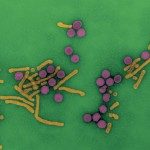Lien vers Pubmed [PMID] – 16652157
Oncogene 2006 Sep;25(40):5475-84
The E1A-targeted transcription factor E4F1 is a key player in the control of mammalian embryonic and somatic cell proliferation and survival. Mouse embryos lacking E4F die at an early developmental stage, whereas enforced expression of E4F1 in various cell lines inhibits cell cycle progression. E4F1-antiproliferative effects have been shown to depend on its capacity to repress transcription and to interact with pRb and p53. Here we show that full-length E4F1 protein (p120(E4F1)) but not its E1A-activated and truncated form (p50(E4F1)), interacts directly in vitro and in vivo with the LIM-only protein FHL2, the product of the p53-responsive gene FHL2/DRAL (downregulated in rhabdomyosarcoma Lim protein). This E4F1-FHL2 association occurs in the nuclear compartment and inhibits the capacity of E4F1 to block cell proliferation. Consistent with this effect, ectopic expression of FHL2 inhibits E4F1 repressive effects on transcription and correlates with a reduction of nuclear E4F1-p53 complexes. Overall, these results suggest that FHL2/DRAL is an inhibitor of E4F1 activity. Finally, we show that endogenous E4F1-FHL2 complexes form in U2OS cells upon UV-light-induced nuclear accumulation of FHL2.

